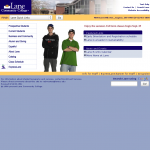Let’s think way back for a minute, to a time when Gnarls Barkley’s “Crazy” was #2 on the charts and people were just starting to watch OK Go dance on treadmills. To when we got used to Daniel Craig as James Bond, and to Al Gore being on the big screen. To when Pluto was still a planet. To the last time Lane got a new webpage.
At the time, we had a nice, modern website. Unfortunately, our story isn’t much different from the guy who owns the nicest VCR on the block – times have changed. Our website was designed before there was an Internet Explorer 7 or any version of Google Chrome. There was no such thing as social media: both Facebook and Twitter launched to the general public after our last redesign. And perhaps most importantly, no one was looking at websites on cell phones – the iPhone wasn’t released until almost a year later.
I think we can all agree that Lane is (over) due for an update.
Our mission this year is to realize that update. But this isn’t a small task. Ever after three months of intense cleaning, Lane’s website has 11,795 pages of HTML files living on our server. If we want to update the design, we need to make a change to each and every one of those files. In other words, even if we started today, we wouldn’t be able to finish before it was time for the next redesign. Plus, we wouldn’t be fixing the information architecture of our site – we wouldn’t be making things easier to find.
So we’re going to build the next generation of the Lane website using a technology called a Content Management System (CMS). A CMS is going to offer us a lot of awesome things in the near future:
- The ability to modify and change the website from anywhere in the world, at any time of day.
- The separation of presentation and content – we’ll be able to change the design of the entire website without having to worry about what’s happening to the content.
- Editing from the browser – no need to download any special software, just fire up your web browser and get to work.
- A mobile version of each page – because presentation and content are separate, it’s easy to serve the same content with a design optimized for a mobile device.
The CMS we’ve picked is called Drupal, an open source project that powers all sorts of important websites, including The Economist and the White House as well as a number of university websites right here in our backyard such as the University of Oregon and Portland State University.
Obviously, a transition like this isn’t going to happen all at once. In fact, this one is going to take until summer, and we’ve already been working on it for almost a year! We’ll do as much as we can to keep you posted on changes through this blog. Expect a post in the not too distant future about some of the changes you’ll notice before we officially launch the new design.


